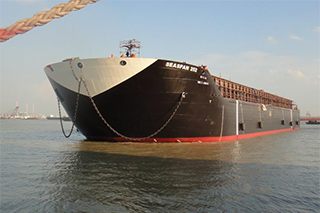Seaspan Marine recently took delivery of a new 16,000 dwt. deck cargo barge, Seaspan 252. Designed by Robert Allan Ltd., the 374'x90'x27'6" barge was built at Jiangsu Yanzijiang Shipbuilding Co. Ltd., in China. Seabridge Marine Contractors Ltd. acted as project manager for the new barge. Seaspan, Robert Allan and Seabridge are all located in Vancouver, British Columbia. The Seabridge tug Pacific Hickory is currently towing the new barge to Vancouver and is due to arrive in late September. It will be put into service hauling limerock from Canada’s Texada Island to Portland, Ore.
“Robert Allan has designed about 20% of our barges and 50% of our tugs,” said Seaspan spokesperson Kelly Francis. “Seabridge oversaw the construction of the barge in China, and they are overseeing the transfer of the Seaspan 252 to Vancouver.”
The new barge has a flush deck and raised forecastle, and the hull form includes a semi-spoon, seagoing bow, round bilges and a stern rake with sidewall skegs, according to the designer. A steel cargo box, measuring 3 meters in height, surrounds the main deck. The limerock is loaded by a shore-mounted conveyor system.
Unloading is accomplished with the use of two large front end loaders which operate on top of the cargo load, feeding a hopper located amidships that in turn feeds a short shuttle conveyor to shore. A 72-kW John Deere EPA Tier III powered generator installed in a machinery space at the bow operates a conveyor system as well as the deck machinery consisting of an anchor windlass, bridle winch and two mooring capstans.
Seaspan 252 is primarily intended for towing on a hawser, so the barge is fitted with twin skegs aft for directional stability. As this type of skeg can represent 25%-30% of the total resistance of the barge, extensive Computational Fluid Dynamics (CFD) analysis was used by Robert Allan to optimize the skegs and reduce their resistance as much as possible, while still maintaining the necessary towed directional stability. The designer found that the process is much faster and more cost-effective than traditional model testing, especially the directional stability analysis which is very difficult to do accurately in a small or medium-size laboratory tank, according to the designer.
The new barge is ABS Maltese Cross A1 classed and was delivered in August.




